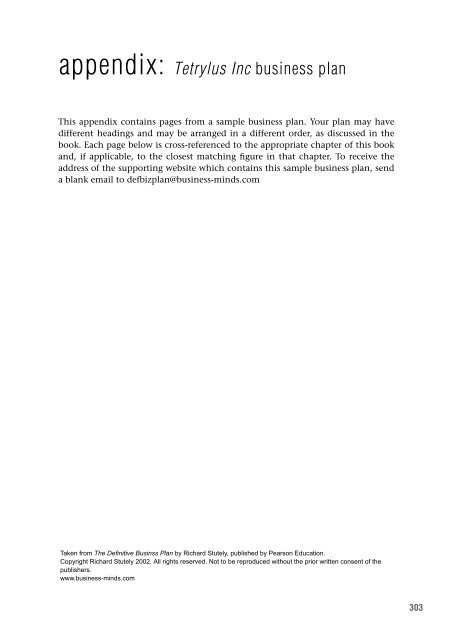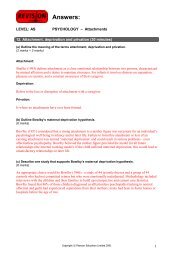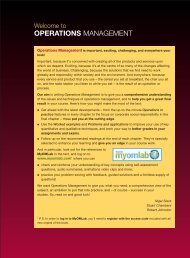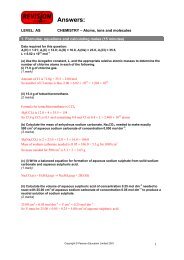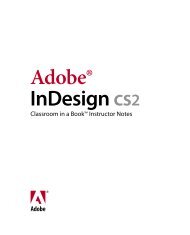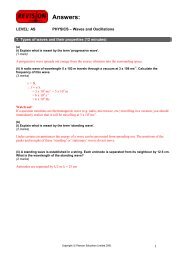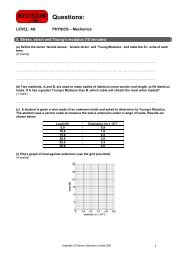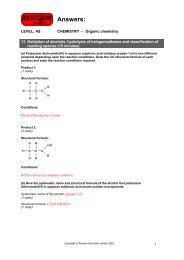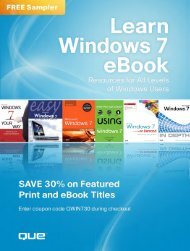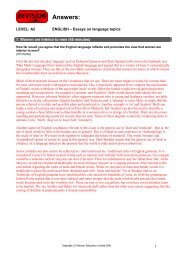appendix: Tetrylus Inc business plan - Pearson
appendix: Tetrylus Inc business plan - Pearson
appendix: Tetrylus Inc business plan - Pearson
Create successful ePaper yourself
Turn your PDF publications into a flip-book with our unique Google optimized e-Paper software.
<strong>appendix</strong>: <strong>Tetrylus</strong> <strong>Inc</strong> <strong>business</strong> <strong>plan</strong><br />
This <strong>appendix</strong> contains pages from a sample <strong>business</strong> <strong>plan</strong>. Your <strong>plan</strong> may have<br />
different headings and may be arranged in a different order, as discussed in the<br />
book. Each page below is cross-referenced to the appropriate chapter of this book<br />
and, if applicable, to the closest matching figure in that chapter. To receive the<br />
address of the supporting website which contains this sample <strong>business</strong> <strong>plan</strong>, send<br />
a blank email to defbiz<strong>plan</strong>@<strong>business</strong>-minds.com<br />
Taken from The Definitive Businss Plan by Richard Stutely, published by <strong>Pearson</strong> Education.<br />
Copyright Richard Stutely 2002. All rights reserved. Not to be reproduced without the prior written consent of the<br />
publishers.<br />
www.<strong>business</strong>-minds.com<br />
303
Appendix<br />
304<br />
1. Cover<br />
See Chapter 2, p. 30<br />
Taken from The Definitive Businss Plan by Richard Stutely, published by <strong>Pearson</strong> Education.<br />
Copyright Richard Stutely 2002. All rights reserved. Not to be reproduced without the prior written consent of the<br />
publishers.<br />
www.<strong>business</strong>-minds.com
2. Contents<br />
See Chapter 3<br />
Contents<br />
Preliminary details<br />
Contact information ........................................................................3<br />
Professional advisers.......................................................................3<br />
Definitions.......................................................................................3<br />
Document control............................................................................3<br />
Legal notice.....................................................................................3<br />
Executive summary ..................................................................................4<br />
Current situation ......................................................................................5<br />
Basic corporate data........................................................................5<br />
Vision, mission, values....................................................................5<br />
History and current status ...............................................................5<br />
Organization and management........................................................6<br />
Infrastructure...................................................................................6<br />
Products and Services .....................................................................6<br />
Core competencies ..........................................................................6<br />
Market analysis.........................................................................................7<br />
The Industry ....................................................................................7<br />
Our market ......................................................................................7<br />
Competitors.....................................................................................7<br />
Competitive advantages ..................................................................7<br />
Strategy and <strong>plan</strong>s....................................................................................8<br />
Objectives........................................................................................8<br />
Strategy ...........................................................................................8<br />
Operating <strong>plan</strong>.................................................................................8<br />
Sales forecasts ...........................................................................................9<br />
Sales volumes..................................................................................9<br />
Production costs ..............................................................................9<br />
Pricing .............................................................................................9<br />
Gross profit from sales ....................................................................9<br />
Financial analysis ...................................................................................10<br />
Breakeven......................................................................................10<br />
Capital spending............................................................................10<br />
Staff costs......................................................................................10<br />
Other operating costs ....................................................................10<br />
<strong>Inc</strong>ome statement/profit and loss account .....................................11<br />
Balance sheet.................................................................................11<br />
Cash flow and funding requirements.............................................11<br />
Valuation .......................................................................................11<br />
Risk analysis............................................................................................12<br />
SWOT – strengths, weaknesses, opportunities and threats...........12<br />
Critical succes factors ...................................................................12<br />
Limiting factors.............................................................................12<br />
Specific risks and their solutions...................................................12<br />
Alternative scenarios.....................................................................12<br />
Sensitivity analysis........................................................................12<br />
Conclusion...............................................................................................13<br />
Annexes....................................................................................................14<br />
A. Detailed financial data..............................................................14<br />
B. Biographies for the top management........................................20<br />
Taken from The Definitive Businss Plan by Richard Stutely, published by <strong>Pearson</strong> Education.<br />
Copyright Richard Stutely 2002. All rights reserved. Not to be reproduced without the prior written consent of the<br />
publishers.<br />
www.<strong>business</strong>-minds.com<br />
Appendix<br />
305
Appendix<br />
306<br />
3. Preliminaries<br />
See Chapter 2, pp. 30–4<br />
Taken from The Definitive Businss Plan by Richard Stutely, published by <strong>Pearson</strong> Education.<br />
Copyright Richard Stutely 2002. All rights reserved. Not to be reproduced without the prior written consent of the<br />
publishers.<br />
www.<strong>business</strong>-minds.com
4. Executive Summary<br />
See Chapter 3, pp. 43–5<br />
Executive Summary<br />
<strong>Tetrylus</strong> is offering 40% of its authorized share capital for $1.25m. This is the<br />
amount of additional funding that we need to meet orders for our unique industrial<br />
computer system and generate net profits of $6m a year by 2005. We are<br />
positioning <strong>Tetrylus</strong> for an initial public offering in that year at an expected market<br />
capitalization of $60m. This Business Plan sets out our strategic, operating and<br />
financial ...<br />
The Company<br />
<strong>Tetrylus</strong> was incorporated in February 2000 with issued share capital of $10,000.<br />
The founder, Niccolò Machiavelli, is well known for his strategic management.<br />
He is supported by René Descartes as Head of Technology. René is famous for his<br />
powers of reasoning and he brings important experience from his previous post as<br />
Head of …<br />
The Product<br />
<strong>Tetrylus</strong> ONE is a package of computer hardware and software that reduces<br />
accidents in dangerous working environments and cuts the cost of complying with<br />
health and safety regulations. Our first users include major petroleum, mining and<br />
construction companies. They recover their full investment in the system within<br />
ten months …<br />
Corporate strategy<br />
Pilot sales confirm that our strategy will be successful. There are five key elements<br />
to our strategy …<br />
Financial projections<br />
Net profit is projected at … Cash flow will turn positive by month 15 and the<br />
potential surplus will reach … Funding requirements peak at … On a realistic<br />
appraisal … pushing the potential return on equity to …<br />
Taken from The Definitive Businss Plan by Richard Stutely, published by <strong>Pearson</strong> Education.<br />
Copyright Richard Stutely 2002. All rights reserved. Not to be reproduced without the prior written consent of the<br />
publishers.<br />
www.<strong>business</strong>-minds.com<br />
Appendix<br />
307
Appendix<br />
308<br />
5. Current situation<br />
See Chapter 4, pp. 53–64<br />
Basic corporate data<br />
Name of Company: <strong>Tetrylus</strong> <strong>Inc</strong><br />
Status: International <strong>business</strong> company<br />
<strong>Inc</strong>orporated in the British<br />
Virgin Islands (BVI) on 29<br />
February 2000.<br />
Capital Authorized: 10,000 ordinary $1 shares.<br />
Issued: One $1 share to Niccolò<br />
Machiavelli<br />
Registered Office: Frond Chambers, Tortola, BVI.<br />
Company no: IBC—3471231<br />
Head Office: 2010 Boston Road, Guesswhere<br />
Vision<br />
<strong>Tetrylus</strong> is dedicated to becoming the world-leader in industrial health and<br />
safety equipment …<br />
Mission<br />
<strong>Tetrylus</strong> mission is to provide excellent industrial health-and-safety<br />
computer systems in Asia-Pacific. We aim to establish a 5% market share<br />
within the next three years, taking sales to over $15 million a year, and net<br />
profits to more than $6 million. We will list on NASDAQ by year five.<br />
During this time period, we will comply with ISO 13000 environmental<br />
standards, provide first-class career development for employees, reduce the<br />
maximum customer-response time to one hour, and work closely with our<br />
shareholders to meet their other objectives.<br />
Company values<br />
We will operate within strict legal and ethical guidelines … We will not test<br />
our product on animals … We will nurture our employee-team and will<br />
introduce measures to promote job satisfaction …<br />
Brief history and current status<br />
<strong>Tetrylus</strong> is in a start-up situation. We have successfully completed one pilot<br />
project that …<br />
Current financial data<br />
The summary below shows that … Financial forecasts are included in the<br />
Financial analysis on pages 11–12 and full historical and forecast data are at<br />
Annex A.<br />
Taken from The Definitive Businss Plan by Richard Stutely, published by <strong>Pearson</strong> Education.<br />
Copyright Richard Stutely 2002. All rights reserved. Not to be reproduced without the prior written consent of the<br />
publishers.<br />
www.<strong>business</strong>-minds.com<br />
y
6. Current situation (continued)<br />
See Chapter 4, pp. 65–72<br />
Organization and management<br />
The management team comprises six professionals with appropriate<br />
qualifications, solid experience, and complementary skills. They have<br />
worked together previously and demonstrated their ability to … Short<br />
résumés are below and detailed biographies are at Annex B.<br />
Organization chart for <strong>Tetrylus</strong> <strong>Inc</strong><br />
Pythagoras<br />
Quality<br />
Rene Descartes<br />
R&D<br />
N. Machiavelli<br />
CEO<br />
Adam Smith<br />
Production<br />
Karl Marx<br />
Sales<br />
Audit<br />
Committee<br />
David Hume<br />
Administration<br />
Production<br />
Our Production Department is headed by Adam Smith. He was one of the<br />
first experts to identify the benefits of specialization and can produce pins<br />
(for identification badges) better than anyone else …<br />
…<br />
Sales<br />
Karl Marx is in charge of Sales. His recognized ability to identify and satisfy<br />
customers’ needs provides us with a significant competitive advantage. His<br />
deputy, Karl Popper, has shown that sales forecasts cannot be proved to be<br />
accurate but can be disproved …<br />
…<br />
Infrastructure<br />
<strong>Tetrylus</strong> is currently operating from the founders’ garage. We have<br />
negotiated a lease for office premises in the Millennium Industrial Park. We<br />
will relocate in the first month of our start-up phase. The office is ideally<br />
situated close to suppliers, customers and the airport …<br />
Products and services<br />
Our launch product is <strong>Tetrylus</strong> ONE – an automated tracking system for<br />
remotely tracking employees in hazardous working environments. The<br />
system comprises a computer software application, radio-frequency network<br />
cards and identification badges with built-in transmitters …<br />
The software is licensed from Arthur Andy and Son, a major international<br />
consulting house. The software is running … The identification badges are<br />
modified versions of badges currently produced by …<br />
Core competencies<br />
A review of the current situation analysis shows that we have developed core<br />
competencies in the following areas …<br />
Taken from The Definitive Businss Plan by Richard Stutely, published by <strong>Pearson</strong> Education.<br />
Copyright Richard Stutely 2002. All rights reserved. Not to be reproduced without the prior written consent of the<br />
publishers.<br />
www.<strong>business</strong>-minds.com<br />
Appendix<br />
309
Appendix<br />
310<br />
7. Market analysis<br />
See Chapter 5, pp. 75–94<br />
Market Analysis<br />
The industry<br />
The product class is industrial health and safety monitoring and compliance<br />
equipment (HSMCE). There are two product categories: non-automated and<br />
computerized. <strong>Tetrylus</strong> is in the latter category …<br />
Our market<br />
The market divides into six segments. There are three industry types<br />
(construction, mining and petroleum) each divided into large and small<br />
companies (the boundary being 2000 manual workers and above). <strong>Tetrylus</strong><br />
is targeting primarily large petroleum companies. The other large companies<br />
are secondary targets for us, but are not ruled out. Small companies are<br />
currently not viable prospects on cost grounds …<br />
<strong>Tetrylus</strong> is operating in Asia-Pacific. Mining and petroleum companies have<br />
fairly homogeneous buying characteristics throughout the region, but the<br />
construction industry is more fragmented. Hong Kong and China …<br />
Competitors<br />
Four major international competitors are operating within our territory.<br />
Together they dominated 94% of the market last year, as Table 7 indicates:<br />
Table 7. Asia-Pacific HSMCE sales by competitor<br />
Company Sales, $m Market share, %<br />
Pacific Link 166 46<br />
Atlantic Watch 87 24<br />
Indian Continental 74 20<br />
Arctic Assets 13 4<br />
Other 21 5<br />
SafeTRAK 1 1<br />
Total 362 100<br />
However, when taken by market segment the picture is rather different.<br />
HSMCE sales by competitor, market segment, and territory are shown in<br />
Table 8…<br />
Competitive advantages<br />
Our research indicates that there are four areas where <strong>Tetrylus</strong> ONE has<br />
distinct competitive advantages. These are …<br />
By exploiting these advantages we can construct effective barriers to entry<br />
which will deter competitors from trying to enter our prime market until …<br />
Taken from The Definitive Businss Plan by Richard Stutely, published by <strong>Pearson</strong> Education.<br />
Copyright Richard Stutely 2002. All rights reserved. Not to be reproduced without the prior written consent of the<br />
publishers.<br />
www.<strong>business</strong>-minds.com
8. Strategy and operating <strong>plan</strong><br />
See Chapter 6, pp. 97–120<br />
Business strategy<br />
Objectives<br />
Our strategic objectives are as follows:<br />
1. Annual sales volumes in the range shown in Table 16, column D.<br />
2. Completion of modifications to hardware as described in Table 17 by<br />
the dates indicated.<br />
3. Completion of modifications to software as described in Table 17 by<br />
the dates indicated.<br />
4. …<br />
Strategy<br />
The market analysis on page 00 indicates that we can take advantage of an<br />
unexploited market niche – automated safety systems for large petroleum<br />
companies operating in Asia-Pacific. The main countries …<br />
We were the first to spot the gap in the market and our exclusive licence for the<br />
identification badge locks out the main competitors. We estimate that there will<br />
be a 15-month time lag before they are in a position to compete… by which time<br />
we have achieved critical mass and the market will be unattractive to them for<br />
the reasons explained … We will also use the revenue from the first sales to<br />
develop …<br />
In essence, our strategy is to:<br />
• Work with ISPs to enable fast deployment of our system using their relationships<br />
and resources. We have signed exclusive agreements with …<br />
• Pursue the strategic sales indicated Table 16, column C that will take us<br />
to critical mass most-rapidly and lock out the major competitors.<br />
• Use revenue for the initial sales to erect barriers to entry as shown in …<br />
Operating <strong>plan</strong><br />
There are three main elements to our operating <strong>plan</strong>, relating to production,<br />
marketing and sales, and administrative support. These are considered in<br />
the following paragraphs …<br />
Production …<br />
Marketing and Sales …<br />
Administrative Support<br />
Taken from The Definitive Businss Plan by Richard Stutely, published by <strong>Pearson</strong> Education.<br />
Copyright Richard Stutely 2002. All rights reserved. Not to be reproduced without the prior written consent of the<br />
publishers.<br />
www.<strong>business</strong>-minds.com<br />
Appendix<br />
311
Appendix<br />
312<br />
9. Sales forecasts<br />
See Chapter 8, pp. 143–65<br />
Sales forecasts<br />
<strong>Tetrylus</strong> ONE reduces the number of accidents at work and cuts the cost<br />
of complying with health and safety legislation. Companies will recover in<br />
10 months their entire initial investment in buying the hardware, licensing<br />
the software and implementing the system. Moreover …<br />
Sales volumes<br />
The limiting factor on sales volumes might be our ability to implement<br />
enough systems in a given period of time. We can solve this by selling<br />
through ISPs and using their technical staff to implement our systems for<br />
end-users. This cuts our resource requirements and reduces the sales cycle<br />
(since ISP’s will leverage existing customer relationships). Moreover, we are<br />
increasing the incentive for ISPs to re-sell <strong>Tetrylus</strong> ONE by allowing them to<br />
earn a high margin on the product while also earning from sales of their<br />
consulting and implementation services.<br />
….<br />
We have already appointed three ISPs, and we expect to recruit one more this<br />
year. We will continue to add ISPs – until we have 20 in year 5. We are<br />
working with current ISPs to develop specific prospective sales. We have<br />
three pilot sales at contract-negotiation stage, and we will make a total of<br />
four sales during this year …<br />
Our target is to sell an average of 2500 <strong>Tetrylus</strong> ONE identity badges with<br />
each sale by year 3. Initial sales will be smaller because …<br />
Production costs<br />
TechnoWhiz will produce identity badges for us. This will reduce the<br />
resources that we require and limit our manufacturing risks – TechnoWhiz<br />
have already produced prototypes that meet or exceed our quality<br />
specifications. Initial costs of $50 a badge will fall to $23 in year 2. Our<br />
projected volumes allow …<br />
Pricing<br />
Longer-term, sales will average a little over $100 000 per package. Pilot<br />
sales aimed at establishing references sites will be smaller values. The<br />
following table shows the composition of a <strong>Tetrylus</strong> ONE package …<br />
Gross profit from sales<br />
The following table indicates that gross profit from sales will reach …<br />
Taken from The Definitive Businss Plan by Richard Stutely, published by <strong>Pearson</strong> Education.<br />
Copyright Richard Stutely 2002. All rights reserved. Not to be reproduced without the prior written consent of the<br />
publishers.<br />
www.<strong>business</strong>-minds.com
10. Financial analysis<br />
See Chapters 10 & 11, pp. 195–248<br />
Financial analysis<br />
Break even<br />
We pass break even when we sell more than 124 <strong>Tetrylus</strong> ONE packages at<br />
a minimum price of $95 000 each …<br />
We believe that we can comfortably achieve this break even level even on a<br />
worst case scenario with …<br />
Capital Spending<br />
Production of <strong>Tetrylus</strong> ONE requires the following equipment … We will<br />
minimize capital outlays by leasing … but we need to own the … for the<br />
strategic opportunities outlined on page 195.<br />
Staff costs<br />
Our major operating costs relate to staffing the … To minimize our<br />
commitments while sales are being established we will sub-contract …<br />
Other operating costs<br />
Table 10.1 shows that the largest non-staff operating costs are …<br />
Taken from The Definitive Businss Plan by Richard Stutely, published by <strong>Pearson</strong> Education.<br />
Copyright Richard Stutely 2002. All rights reserved. Not to be reproduced without the prior written consent of the<br />
publishers.<br />
www.<strong>business</strong>-minds.com<br />
Appendix<br />
313
Appendix<br />
314<br />
11. Financial analysis<br />
See Chapter 10, pp. 196–211<br />
<strong>Inc</strong>ome statement/profit & loss account<br />
The revenues and costs described above are brought together in the profit<br />
and loss account in Table 12 (full details are in Annex A). The $1.4m net<br />
loss in year 1 reduces to $0.2m in year 2 and turns to a net profit of $3.8m<br />
by year 3. Sales could …<br />
Balance sheet<br />
A summarized balance sheet is shown in Table 13 (full details are in Annex<br />
A). By year 5, retained earnings exceed $12m and net asset value is …<br />
Cash flow and funding requirements<br />
The following chart illustrates our cumulative cash flow projection<br />
(Detailed figures are in Annex A). Monthly cash inflows start to exceed<br />
outflows by month 14 and we move into a surplus by month 30. Our<br />
maximum funding requirement is $1.25 million …<br />
$4m<br />
3<br />
2<br />
1<br />
0<br />
–1<br />
–2<br />
…<br />
Cumulative cash flow projection<br />
Year 1 Year 2 Year 3 Year 4 Year 5<br />
Valuation<br />
On a modest price earnings multiple of 10, the implied market value of the<br />
equity capital will be nearly $40m by year 3 … This would represent a<br />
potential return on investment of … Also …<br />
Taken from The Definitive Businss Plan by Richard Stutely, published by <strong>Pearson</strong> Education.<br />
Copyright Richard Stutely 2002. All rights reserved. Not to be reproduced without the prior written consent of the<br />
publishers.<br />
www.<strong>business</strong>-minds.com
12. Risk analysis<br />
See Chapter 11, pp. 223–49<br />
RISK assessment<br />
SWOT<br />
We have analyzed our strengths and weaknesses, and the opportunities for<br />
and threats to the <strong>business</strong>. The key items are listed below, each with a note<br />
explaining how we will cope with, or exploit, the issue …<br />
Critical success factors<br />
We have determined that we must achieve the following targets in order to<br />
move our strategy forward. Most critical is the need to source … We are<br />
implementing a four-step program to ensure that we meet the requirements<br />
… The first step is to …<br />
Limiting factors<br />
There are two things which could limit our sales in year one and … First,<br />
there is a constraint on the amount of … that we can source until we have …<br />
Of course, these limits are way beyond the sales volumes that we can<br />
reasonably hope to achieve. Moreover, …<br />
Specific risks and their solutions<br />
There are eight specific risks to which we should draw attention … We have<br />
strategies to deal with each of these risks, as described below.<br />
Production. <strong>Tetrylus</strong> ONE has been successfully prototyped and the<br />
feasibility and cost of the manufacturing process is known. The<br />
manufacturing is undertaken by a company with quality procedures that<br />
meet ISO 9002 standards, and we will conduct our own quality control<br />
sampling at their premises … The one remaining uncontrollable factor<br />
affecting production is the availability and price of silicon on the world<br />
market which …<br />
Alternative scenarios<br />
Our sales forecasts, and projected revenues, costs, and financial statements<br />
are based on the lower-end of our most-likely scenario.<br />
As already discussed, there is a range of possible outcomes dependent on a<br />
wide range of factors both within and outside of our control. Accordingly,<br />
this <strong>plan</strong> includes two alternative scenarios showing how the <strong>business</strong> will<br />
develop under varying conditions. The low-income scenario assumes that<br />
certain unlikely events depress production, sales and prices by … Our<br />
calculations show that we still break even at … and … . We also include a<br />
high-income scenario to show how net profit will rise sharply if …<br />
Sensitivity analysis<br />
The following table shows our assessment of the effects of a 1% increase in<br />
key variables. A 1% decline will have approximately the opposite effect.<br />
You may use this table to assess your own scenarios.<br />
A 1% increase in Net profit<br />
Will change these by<br />
Borrowing ROE<br />
$,000 $,000 %<br />
Sales volume +167 –83 +3.3<br />
Sales price +134 –57 +2.7<br />
Marketing expenditure +15 –8 +0.3<br />
Raw material prices –59 +30 –1.2<br />
Labour costs –23 +12 –0.5<br />
Other costs –12 +5 –0.2<br />
Taken from The Definitive Businss Plan by Richard Stutely, published by <strong>Pearson</strong> Education.<br />
Copyright Richard Stutely 2002. All rights reserved. Not to be reproduced without the prior written consent of the<br />
publishers.<br />
www.<strong>business</strong>-minds.com<br />
Appendix<br />
315
Appendix<br />
316<br />
13. Conclusion<br />
See Chapter 3, p. 46<br />
Taken from The Definitive Businss Plan by Richard Stutely, published by <strong>Pearson</strong> Education.<br />
Copyright Richard Stutely 2002. All rights reserved. Not to be reproduced without the prior written consent of the<br />
publishers.<br />
www.<strong>business</strong>-minds.com
14. Annex A1. Production and sales<br />
See Chapter 8, p. 166<br />
ANNEX A.1 Production and sales<br />
Note: Depending on the purpose of your <strong>plan</strong>, you will almost certainly need to include projections<br />
for a longer time period than the six months shown here. You may want to show details for the first<br />
few months of the future period, and perhaps annual figures for three to five years ahead. You will<br />
also include historical figures if the <strong>business</strong> is already in existence.<br />
TETRYLUS <strong>Inc</strong> Financial <strong>plan</strong><br />
Production and sales, first six months<br />
Dollars<br />
Month 1 Month 2 Month 3 Month 4 Month 5 Month 6<br />
G-1 Costs and prices<br />
G-2 Production cost, per unit 0 50 50 50 50 50<br />
G-3<br />
G-4<br />
Sales price, per unit 0 78 78 78 78 78<br />
G-5 Inventory volume<br />
G-6 Opening stock (prev 9) 0 0 300 800 350 850<br />
G-7 Addition (production volume) 0 500 500 0 500 0<br />
G-8 Reduction (sales volume) 0 –200 0 –450 0 –600<br />
G-9<br />
G-10<br />
Closing stock (6 + 7 + 8) 0 300 800 350 850 250<br />
G-11 Inventory value<br />
G-12 Opening stock (prev 15) 0 0 15 000 40 000 17 500 42 500<br />
G-13 Addition (line 2 x line 7) 0 25 000 25 000 0 25 000 0<br />
G-14 Reduction (line 2 x line 8) 0 –10 000 0 –22 500 0 –30 000<br />
G-15<br />
G-16<br />
Closing stock (12 + 13 + 14) 0 15 000 40 000 17 500 42 500 12 500<br />
G-17 Gross sales<br />
G-18 Hardware (line 3 x line 8) 0 15 600 0 35 100 0 46 800<br />
G-19 Software 0 4 400 0 4 900 0 3 200<br />
G-20<br />
G-21<br />
Total sales (lines 18 + 19) 0 20 000 0 40 000 0 50 000<br />
G-22 Cost of sales<br />
G-23 Hardware (line 2 x line 8) 0 10 000 0 22 500 0 30 000<br />
G-24 Software (from software account) 0 3 591 0 4 683 0 3 979<br />
G-25<br />
G-26<br />
Total cost (lines 23 + 24) 0 13 591 0 27 183 0 33 979<br />
G-27 Gross profit<br />
G-28 Hardware (line 18 – line 23) 0 5 600 0 12 600 0 16 800<br />
G-29 Software (line 19 – line 24) 0 809 0 217 0 –779<br />
G-30<br />
G-31<br />
Total (lines 28 + 29) 0 6 409 0 12 817 0 16 021<br />
G-32 Gross profit, %<br />
G-33 Hardware (line 28 / line 18) 0 36 0 36 0 36<br />
G-34 Software (line 29 / line 19) 0 18 0 4 0 –24<br />
G-35 Total (line 30 / line 20) 0 32 0 32 0 32<br />
Taken from The Definitive Businss Plan by Richard Stutely, published by <strong>Pearson</strong> Education.<br />
Copyright Richard Stutely 2002. All rights reserved. Not to be reproduced without the prior written consent of the<br />
publishers.<br />
www.<strong>business</strong>-minds.com<br />
Appendix<br />
317
Appendix<br />
318<br />
15. Annex A2. Capital outlays<br />
See Chapter 9, p. 178<br />
ANNEX A.2 Capital outlays<br />
TETRYLUS <strong>Inc</strong> Financial <strong>plan</strong><br />
Total capital outlays and depreciation, first six months<br />
Dollars<br />
Month 1 Month 2 Month 3 Month 4 Month 5 Month 6 H1<br />
C-11<br />
CAPITAL OUTLAYS<br />
Office fittings 6 500 0 0 0 0 0 6 500<br />
C-12 Office furniture 5 000 0 0 0 0 0 5 000<br />
C-13 Office equipment 0 0 750 0 0 0 750<br />
C-14 Telecoms equipment 0 0 0 0 0 0 0<br />
C-15 Computers, etc. 20 000 1 500 0 1 000 0 0 22 500<br />
C-16 Software 5 000 0 0 0 0 0 5 000<br />
C-17 Motor vehicles 0 0 0 0 0 0 0<br />
C-00 TOTAL CAPITAL OUTLAYS 36,500 1 500 750 1 000 0 0 39 750<br />
DEPRECIATION SCHEDULE<br />
D-11 Office fittings 0 542 542 542 542 542 2 708<br />
D-12 Office furniture 0 83 83 83 83 83 417<br />
D-13 Office equipment 0 0 0 13 13 13 38<br />
D-14 Telecoms equipment 0 0 0 0 0 0 0<br />
D-15 Computers, etc. 0 556 597 597 625 625 3 000<br />
D-16 Software 0 208 208 208 208 208 1 042<br />
D-17 Motor vehicles 0 0 0 0 0 0 0<br />
D-00 TOTAL 0 1 389 1 431 1 443 1 471 1 471 7 204<br />
Notes to the accounts: depreciation policy<br />
Fixed assets are written-off over their projected working lives using the straight-line method. Office<br />
fittings are depreciated over the 12-month term of the office lease; office furniture and equipment is<br />
depreciated over 60 months, computers over 36 and software over 24 months.<br />
Commentary (extract)<br />
Line S-00 – Total salaries<br />
Total spending on salaries is based on headcount projections and expected salary levels (as described …)<br />
Line S-11 Director stipends<br />
There is a modest $10,000 a month to cover the directors’ basic living costs and commitments. This will be<br />
increased toward market levels once the <strong>business</strong> is generating sustained positive cash flow.<br />
Line S-12 Deliberately omitted<br />
Line S-13 Contract staff<br />
To avoid the commitment associated with increasing the permanent staff complement, and to add to the range of<br />
resources available, a number of technical staff will be employed on a contract basis. Their costs are shown on<br />
page 178 and the total is included in line S-13.<br />
Line E-11 Premises rental and taxes<br />
We have a one-year lease on premises at Millennium Park, The lease is fixed at $12,000 for the period and it is<br />
payable monthly in advance commencing in month 1.<br />
Line E-12 Amortisation – leasehold improvements<br />
This is the initial office fitting costs (described on page 178 written-off over the 12-month term of the lease.<br />
Line E-13 Utilities<br />
We estimate spending on electricity and water at a little over $500 a month. There will be an annual price increase<br />
in month 11 – we have provided for the maximum likely rise of 10%.<br />
Taken from The Definitive Businss Plan by Richard Stutely, published by <strong>Pearson</strong> Education.<br />
Copyright Richard Stutely 2002. All rights reserved. Not to be reproduced without the prior written consent of the<br />
publishers.<br />
www.<strong>business</strong>-minds.com
16. Annex A3. Staff costs<br />
See Chapter 9, p. 181<br />
ANNEX A.2 A.3 Capital Staff costs<br />
outlays<br />
SafeTRAK <strong>Inc</strong> Financial <strong>plan</strong><br />
Staff costs, first six months<br />
Dollars<br />
Month 1 Month 2 Month 3 Month 4 Month 5 Month 6 H1<br />
STAFF NUMBERS<br />
Directors/managers 3 3 3 3 3 3 3<br />
Technical staff 2 4 4 4 4 4 4<br />
Marketing staff 0 1 1 2 2 2 2<br />
Administrative staff 2 2 2 2 2 3 3<br />
Total 7 10 10 11 11 12 12<br />
S-1<br />
STAFF COSTS<br />
Staff salaries<br />
Technical staff 1 1 200 1 200 1 200 1 200 1 200 1 200 7200<br />
S-2 Technical staff 2 1 200 1 200 1 200 1 200 1 200 1 200 7200<br />
S-3 Technical staff 3 . 1 200 1 200 1 200 1 200 1 200 6000<br />
S-4 Technical staff 4 . 1 200 1 200 1 200 1 200 1 200 6000<br />
S-5 Sales/distribution manager . . . 1 250 1 259 1 250 3759<br />
S-6 Marketing assistant . 750 750 750 750 750 3750<br />
S-7 Book-keeping, etc. . . . . . 750 750<br />
S-8 Receptionist/secretary 600 600 600 600 600 600 3600<br />
S-9 Messenger/security 300 300 300 300 300 300 1800<br />
S-00 TOTAL (sum S1 to S9) 3 300 6 450 6 450 7 700 7 709 8 450 40 059<br />
S-11 Directors’ stipends 10 000 10 000 10 000 10 000 10 000 10 000 60 000<br />
S-13 Contract staff 10 000 10 000 10 000 10 000 10 000 10 000 60 000<br />
S-14 Staff social security 92 162 162 185 185 208 992<br />
S-15 Staff temporary 0 0 0 0 0 0 0<br />
S-10 TOTAL DIRECT (11 to 19) 23 392 26 612 26 612 27 885 27 894 28 658 161 051<br />
S-21 Staff pension fund 417 417 417 417 417 417 2500<br />
S-22 Staff termination fund 0 0 0 0 0 0 0<br />
S-23 Staff rent allowances 0 0 0 0 0 0 0<br />
S-24 Staff transport allowances 0 0 0 0 0 0 0<br />
S-25 Staff other allowances 0 0 0 0 0 0 0<br />
S-26 Staff group insurance 0 0 0 0 0 0 0<br />
S-27 Staff medical insurance 500 0 0 0 0 0 500<br />
S-28 Staff other benefits 0 0 0 0 0 0 0<br />
S-20 TOT. BENEFITS (21 to 29) 917 417 417 417 417 417 3 000<br />
S-31 Staff medical expenses 0 0 0 0 0 0 0<br />
S-32 Staff recruitment 0 0 0 0 0 0 0<br />
S-33 Staff relocation 0 0 0 0 0 0 0<br />
S-34 Staff legal expenses 1 500 0 0 0 0 0 1500<br />
S-36 Staff training 0 0 0 0 0 0 0<br />
S-38 Staff entertainment 70 100 100 110 110 120 610<br />
S-39 Staff sundry 0 0 0 0 0 0 0<br />
S-30 TOTAL OTHER (31 to 39) 1 570 100 100 110 110 120 2 110<br />
S-00 TOTAL STAFF (10+20+30) 25 879 27 128 27 128 28 411 28 420 29 194 166 161<br />
Taken from The Definitive Businss Plan by Richard Stutely, published by <strong>Pearson</strong> Education.<br />
Copyright Richard Stutely 2002. All rights reserved. Not to be reproduced without the prior written consent of the<br />
publishers.<br />
www.<strong>business</strong>-minds.com<br />
Appendix<br />
319
Appendix<br />
320<br />
17. Annex A4. Non-staff operating costs<br />
See Chapter 9, p. 186<br />
ANNEX A.4 Non-staff operating costs<br />
TETRYLUS <strong>Inc</strong> Financial <strong>plan</strong>,<br />
Operating costs, first six months<br />
Dollars<br />
Month 1 Month 2 Month 3 Month 4 Month 5 Month 6 H1<br />
E-11 Premises rental & taxes 1 000 1 000 1 000 1 000 1 000 1 000 6 000<br />
E-12 Amort’n – lease improvem’ts 0 542 542 542 542 542 2 708<br />
E-13 Utilities – electricity, etc. 500 500 500 500 500 500 3 000<br />
E-10 TOTAL OCCUPANCY 1 500 2 042 2 042 2 042 2 042 2 042 11 708<br />
E-21 Dep’n – office furniture 0 83 83 83 83 83 417<br />
E-22 Dep’n – office equipment 0 0 0 13 13 13 38<br />
E-23 Small equipment 100 100 0 0 0 0 200<br />
E-24 Stationery & printing 100 25 25 25 25 25 225<br />
E-25 Dues & subscriptions 100 100 100 100 100 100 600<br />
E-26 Books & periodicals 50 50 50 50 50 50 300<br />
E-27 Other office 50 50 50 50 50 50 300<br />
E-20 TOTAL OFFICE 400 408 308 321 321 321 2 079<br />
E-31 Dep’n – coms. equipment 0 0 0 0 0 0 0<br />
E-32 Telephone & fax 2 500 2 500 2 500 2 500 2 500 2 500 15 000<br />
E-33 Information services 100 100 100 100 100 100 600<br />
E-34 Postage & courier 250 250 250 250 250 250 1 500<br />
E-30 TOTAL COMMS 2 850 2 850 2 850 2 850 2 850 2 850 17 100<br />
E-41 Depreciation – computers 0 556 597 597 625 625 3 000<br />
E-42 Depreciation – software 0 208 208 208 208 208 1 042<br />
E-43 Other software licences 500 0 0 0 0 0 500<br />
E-45 Computer consumables 50 50 50 50 50 50 300<br />
E-40 TOTAL COMPUTERS 550 814 856 856 883 883 4 842<br />
E-51 Product distribution 0 0 500 1 000 300 2 500 4 300<br />
E-52 Brochures and printing 0 5 000 2 500 0 0 0 7 500<br />
E-55 Promotional items 0 2 500 0 0 0 0 2 500<br />
E-59 Other marketing 0 5 000 5 000 0 0 0 10 000<br />
E-50 TOTAL MKTG & SALES 0 12 500 8 000 1 000 300 2 500 24 300<br />
E-61 Depreciation – vehicles 0 0 0 0 0 0 0<br />
E-62 Rental – vehicles 0 0 0 0 0 0 0<br />
E-63 Motor vehicle expenses 0 0 0 0 0 0 0<br />
E-64 Travel & subsistence 5 100 10 100 10 100 10 100 10 100 10 100 55 600<br />
E-65 Entertainment 0 0 0 0 0 0 0<br />
E-60 TOTAL TS&E 5 100 10 100 10 100 10 100 10 100 10 100 55 600<br />
E-71 Audit fees 0 0 0 0 0 0 0<br />
E-72 Legal fees 1 000 2 500 1,000 0 0 0 4 500<br />
E-75 Other professional fees 0 0 0 0 0 0 0<br />
E-70 TOTAL PROFESSIONAL 1 000 2 500 1 000 0 0 0 4 500<br />
E-83 Insurance 1 000 2 500 0 0 0 0 3 500<br />
E-85 Sundry expenditure 100 100 100 100 100 100 600<br />
E-80 TOTAL OTHER 1 100 2 600 100 100 100 100 4 100<br />
E-00 TOTAL EXPENDITURE 12 500 33 814 25 256 17 268 16 596 18 796 124 229<br />
Taken from The Definitive Businss Plan by Richard Stutely, published by <strong>Pearson</strong> Education.<br />
Copyright Richard Stutely 2002. All rights reserved. Not to be reproduced without the prior written consent of the<br />
publishers.<br />
www.<strong>business</strong>-minds.com
18. Annex A5. <strong>Inc</strong>ome/P&L and balance sheet<br />
See Chapter 9, p. 189<br />
ANNEX A.5 <strong>Inc</strong>ome/P&L and balance sheet<br />
TETRYLUS <strong>Inc</strong>, Financial <strong>plan</strong><br />
Profit and loss account, first six months<br />
Dollars<br />
Month 1 Month 2 Month 3 Month 4 Month 5 Month 6 H1<br />
Sales 0 20 000 0 40 000 0 50 000 110 000<br />
Less: Costs of sales 0 13 591 0 27 183 0 33 979 74 753<br />
Gross profit 0 6 409 0 12 817 0 16 021 35 247<br />
Less: Operating costs<br />
Employee costs 25 879 27 128 27 128 28 411 28 420 29 194 166 161<br />
Other expenditure 12 500 33 814 25 256 17 268 16 596 18 796 124 229<br />
Total operating costs 38 379 60 942 52 384 45 679 45 016 4 7990 290 390<br />
Net profit (loss) (38 379) (54 533) (52 384) (32 862) (45 016) (31 969) (255 143)<br />
before contingency, etc.<br />
Less: Contingency 3 838 6 094 5 238 4 568 4 502 4 799 29 039<br />
Net profit (loss) (42 217) (60 627) (57 622) (37 430) (49 518) (36 768) (284 182)<br />
before interest and tax<br />
Balance sheet<br />
Dollars<br />
Month 1 Month 2 Month 3 Month 4 Month 5 Month 6<br />
B-1<br />
Assets<br />
Cash at bank 1 000 1 000 1 000 1 000 1 000 1 000<br />
B-2 Accounts receivable 0 20 000 0 40 000 0 50 000<br />
B-3 Deposits paid 2 000 2 000 2 000 2 000 2 000 2 000<br />
B-4 Repayments (rents) 11 000 10 000 9 000 8 000 7 000 6 000<br />
B-5 Inventory 0 15 000 40 000 17 500 42 500 12 500<br />
B-6 Fixed assets at cost 36 500 38 000 38 750 39 750 39 750 39 750<br />
B-7 Less accumulated depreciation 0 –1 389 –2 819 –4 263 –5 733 –7 204<br />
B-8 Memo: net fixed assets 36 500 36 611 35 931 35 488 34 017 32 546<br />
B-9 Total assets 50 500 84 611 87 931 103 988 86 517 104 046<br />
B-10<br />
B-11 LIABILITIES<br />
B-12 Total loans 91 300 172 031 242 556 268 443 322 573 342 475<br />
B-13 Accounts payable – hardware 0 10 000 0 22 500 0 30 000<br />
B-14 Accounts payable – software 0 3 591 3 591 8 274 8 274 12 253<br />
B-15 Accruals (staff pensions) 417 833 1 250 1 667 2 083 2 500<br />
B-16<br />
B-17<br />
Total liabilities 91 717 186 455 247 397 300 884 332 931 387 228<br />
B-18 CAPITAL & RESERVES<br />
B-19 Share capital 1 000 1 000 1 000 1 000 1 000 1 000<br />
B-20 Unremitted P&L –42 217 –102 844 –160 467 –197 896 –247 414 –284 182<br />
B-21<br />
B-22<br />
Total capital and reserves –41 217 –101 844 –159 467 –196 896 –246 414 –283 182<br />
B-23 Total liabilities and equity 50 500 84 611 87 931 103 988 86 517 104 046<br />
Taken from The Definitive Businss Plan by Richard Stutely, published by <strong>Pearson</strong> Education.<br />
Copyright Richard Stutely 2002. All rights reserved. Not to be reproduced without the prior written consent of the<br />
publishers.<br />
www.<strong>business</strong>-minds.com<br />
Appendix<br />
321
Appendix<br />
322<br />
19. Annex A6. Cash flow<br />
See Chapter 10, p. 209<br />
ANNEX A.6 Cash flow<br />
TETRYLUS <strong>Inc</strong> Financial <strong>plan</strong><br />
Cash flow, first six months<br />
Eurodollars<br />
Month 1 Month 2 Month 3 Month 4 Month 5 Month 6<br />
F-1 Net profit –42 217 –60 627 –57 622 –37 430 –49 518 –36 768<br />
F-2 Adjustments for changes in:<br />
F-3 Cash at bank –1 000 0 0 0 0 0<br />
F-4 Accounts receivable 0 –20 000 20 000 –40 000 40 000 –50 000<br />
F-5 Deposits paid –2 000 0 0 0 0 0<br />
F-6 Prepayments (rents) –11 000 1 000 1 000 1 000 1 000 1 000<br />
F-7 Inventory 0 –15 000 –25 000 22 500 –25 000 30 000<br />
F-8 Fixed assets –36 500 –1 500 –750 –1 000 0 0<br />
F-9 Depreciation 0 1 389 1 431 1 443 1 471 1 471<br />
F-10 Accounts payable - hardware 0 10 000 –10 000 22 500 –22 500 30 000<br />
F-11 Accounts payable - software 0 3 591 0 4 683 0 3 979<br />
F-12 Accrued pensions 417 417 417 417 417 417<br />
F-13 Equity 1 000 0 0 0 0 0<br />
F-14 Cash flow –91 300 –80 731 –70 525 –25 887 –54 130 –19 902<br />
F-15 Cumulative cash flow –91 300 –172 031 –242 556 –268 443 –322 573 –342 475<br />
Notes:<br />
F-3 – there is provision for a working bank balance of $1000.<br />
F-4 & F-10 – 30 days credit is allowed to customers and provided by the hardware supplier.<br />
F-5 – a returnable deposit equivalent to two months’ rent was required by the lessor of the office<br />
premises.<br />
F-6 – office rent is payable 12 months in advance.<br />
F-11 – software licence fees are paid to the supplier annually.<br />
Taken from The Definitive Businss Plan by Richard Stutely, published by <strong>Pearson</strong> Education.<br />
Copyright Richard Stutely 2002. All rights reserved. Not to be reproduced without the prior written consent of the<br />
publishers.<br />
www.<strong>business</strong>-minds.com
20. Annex B. Management biographies<br />
See Chapter 4, p. 66<br />
ANNEX B Management biographies<br />
Niccolò Machiavelli, Chief Executive Officer<br />
Born 3 May, 1469 in Florence, Italy. Niccolò gained fame for his<br />
controversial pamphlet The Prince, which he wrote to gain influence with<br />
the ruling Medici family. Initially a secretary in the Florentine government,<br />
he engaged in diplomatic missions and rubbed shoulders with the great and<br />
famous. He brings strategic insight which will help the company to gain<br />
market share … His other publications include The Art of War and<br />
Discourses on Livy …<br />
Karl Marx, Director of Sales<br />
Born 1818 in Trier, Prussia. Karl studied law and philosophy at Bonn<br />
University and Jena. He bagan his career as a lecturer before becoming a<br />
political journalist and subsequently editor of The Rhenish Gazette. He was<br />
exiled for his views and he moved to London in 1850 … His works include<br />
Das Kapital which became the justification of modern socialism …<br />
Adam Smith, Director of Production<br />
Born 1768 in Kirkcaldy, Scotland. After a scholarship at Oxford, Adam was<br />
appointed Professor of Logic at Glasgow University – and later Professor of<br />
Moral Philosophy. He is the founder of classical and political economics. His<br />
works include Inquiry into the Nature and Causes of the Wealth of Nations<br />
which introduced the concept of the invisible hand of capitalism …<br />
René Descartes, Director of Research & Development<br />
Born March 31, 1596 in Touraine, France. Famous for coining the phrase<br />
‘cogito, ergo sum’ (‘I think, therfore I am’), Descartes is widely held as the<br />
founder of modern philosophy; however, he was also a brilliant<br />
mathematician. Aside from his philosophical works, including Meditations<br />
on First Philosophy, he wrote La Géométrie applying algebra to geometry –<br />
the foundation of cartesian geometry …<br />
If you would be a real seeker after truth,<br />
it is necessary that at least once in your life<br />
you doubt, as far as possible, all things.<br />
René Descartes<br />
A stategy and an action <strong>plan</strong><br />
Taken from The Definitive Businss Plan by Richard Stutely, published by <strong>Pearson</strong> Education.<br />
Copyright Richard Stutely 2002. All rights reserved. Not to be reproduced without the prior written consent of the<br />
publishers.<br />
www.<strong>business</strong>-minds.com<br />
Appendix<br />
323


